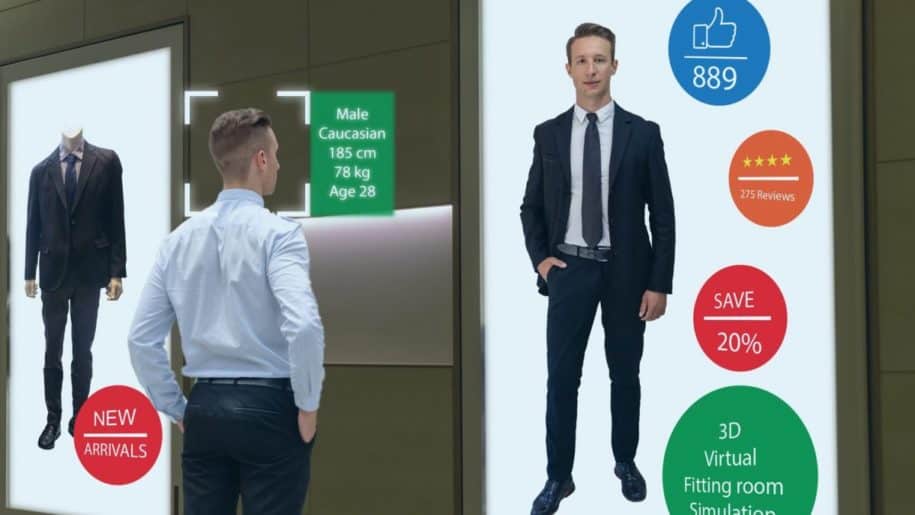The retail industry has experienced numerous changes in recent decades and is one of the sectors of the economy that has benefited most from digitalization. The physical store is no longer the only sales channel, it has been joined by ecommerce and a whole series of hybrid modalities between physical and online stores.
After examining why and how retail is a fast evolving vertical, we’ll take a look at the opportunities offered by Augmented Reality to upgrade how retail sales are managed.
Current trends in Retail
There are a number of current trends that directly and powerfully impact the world of retail and that are worth analyzing. Many of these have emerged in the last decade, or limited in the last two, also thanks to the contribution of the so-called e-tailers, Amazon in the first place.
These trend include:
? Long Tail: the tendency of large online retailers to generate the majority of revenues from the sale of niche products, rather than from the more popular products. In practice, players like Amazon and Netflix have overturned the Pareto principle. Physical stores, as they are organized today, find it very difficult to follow the long tail model, because of physical and logistical constraints they tend to favor the best selling products, despite an extremely wide proposal in terms of references.
? Mass Customization: a complementary trend compared to the previous one is mass customization, that is the ability of retailers to sell highly personalized products in terms of characteristics (material, color, configuration, etc.), highly appreciated by consumers who are increasingly looking for unique products and fewer and fewer standard products. This trend has also had a strong impact on production systems which have inevitably become more flexible and which carry out less and less series production.
? Showrooming: this trend identifies the behavior of those consumers who use physical stores as product showcases and as places to try the product, finalizing the purchase process online. It is a very common behavior in the clothing sector, as showrooming allows people to try on shoes or clothes in order to identify the right size and evaluate comfort/fit.
? Superior Customer Service: although physical store managers have the advantage of having a direct relationship with their customers, online stores, over time, have come to offer extremely high and flexible levels of service, to which people got used very soon. The areas where online retailers make a difference include flexibility in the management of dissatisfied customers, for example by offering free returns and full refunds even up to 30 days after purchase; offers in all seasons of the year; the order processing times (often in less than 24 hours customers receive the goods at home); loyalty and reward mechanisms; multiple payment methods, from credit card to cryptocurrency wallet; even the “lowest price guaranteed” policy with the possibility of refunding the difference if the same product is available at a lower price on other stores.
Retail markets size and growth rate
The global retail market, online and offline, in 2017 reached a value of 23.460 billion dollars and for the period 2018-2023 an average growth rate of 5.3% per year is expected, up to the value of 31.881 billions of dollars in 2023 (Source: Markets and Markets).
Although in the last ten years eCommerce has grown at an average of +15% per year, it now represents only about 10% of the global retail market, therefore 90% of today’s purchases still take place in physical stores. According to the most recent forecasts, e-commerce will reach 17.5% of the value of the Retail market in 2021 (Source: Statista).

The most competitive categories in offline retail are food, household goods and cosmetics; while the three most competitive categories in online channels are products for entertainment (music, books, films), electronics (computers and smartphones) and products for the home.
Depending on the nature of the product, some categories find a more natural outlet in offline rather than online channels. For example, all food products, especially fresh ones, have, and will have, for a certain period of time still, a more advantageous outlet in the offline channel; while for example products that are easily dematerialized, such as music and films, can be sold more easily through online channels.

Since data and forecasts still see a large share of sales for physical stores in Retail, we will focus on both online and offline Augmented Reality solutions.
Augmented Reality solutions for Retail
After explaining why users expect to experiment a customer-centric shopping experience, focused on customization rather than standardization, we’ll take a look at some of the most interesting Augmented Reality use cases for the Retail industry.
Augmented Reality Product Presentation
Online
When a customer is considering buying a physical product online, she may put a lot of emphasis on the product presentation, especially for certain categories including furniture, clothing and technology. The presentation of products through the online channels can be made more engaging and realistic using Augmented Reality techniques like AR product visualization with spatial mapping. In most cases this goal can be achieved by using the customer’s device, typically a smartphone or a tablet.
Offline
Even if in a store you are able to see the products in person it can be more interactive to provide innovative interfaces to customers, allowing them to discover in-depth features of the product. In terms of hardware, in-store Augmented Reality requires dedicated devices such as big touch screens and/or wearable devices.

Augmented Reality Configuration
Online
Enabling Augmented Reality product presentation could not be enough, since the customer that is buying online may want to evaluate different configurations of the product to find the one that satisfies her the most. This process involves picking different colors, materials, sizes and can be a great addition to your marketing strategy.
Offline
The product configuration process can be implemented in stores to allow potential customers to experiment with all the possible product declinations in order to find the most suited one. At this stage customers can use the same devices used at the product presentation stage.

Augmented Reality Try On
Online
When the potential customer has narrowed the choice among a handful of products, she may want to try them on, depending on the product category. This is a doable approach for clothes, make-up, jewelry, and watches. The technology today offers the tools to enable Augmented Reality try on by recognizing the users’ body, face and hands, following her movements and adapting accordingly.
Offline
In a in-store context virtual try on can be achieved by using large interactive mirrors, special displays endowed with depth cameras, and by visualizing the customer’s shape on the screen with additional (augmented) digital contents such as clothes.

